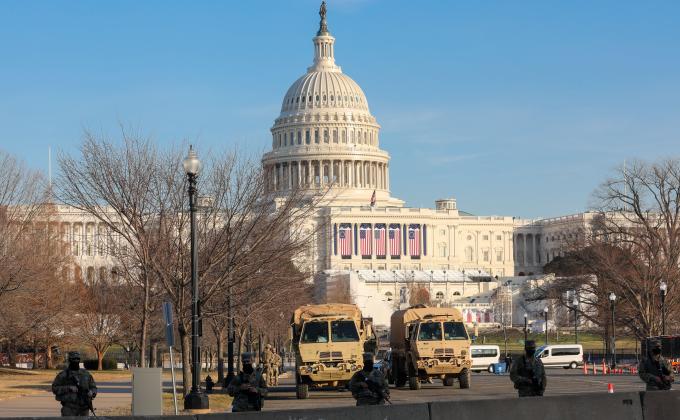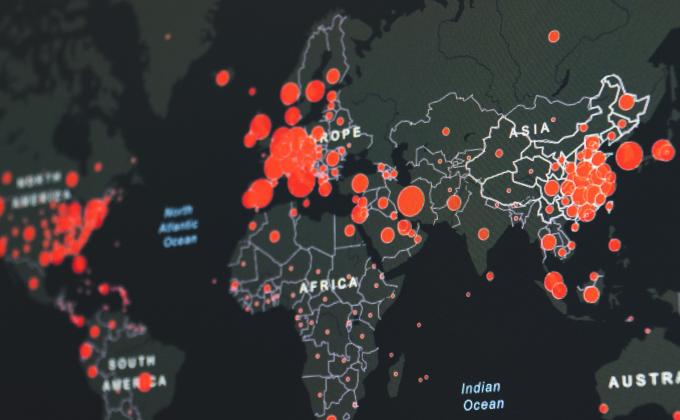In the United States and across Europe, there is a broad recognition that right-wing extremism has become either the main terrorist threat, or at the very least a seriously growing concern. The racially motivated attack by an 18-year-old in May 2022 in Buffalo (NY), deliberately targeting African Americans and killing ten people before being arrested, was but the latest in a long series of lethal right-wing plots and attacks in the West. In parallel, a relative decline of jihadi activities in Western countries has been noted, resulting in a new balance of (perceived) terrorist threats.
Although recognising the intellectual appeal of such discussions, the very concrete policy implications to it are actually more critical. Any attempt at anticipating the evolution of the threat drives the allocation of counter-terrorism resources in a certain direction. In the UK, for instance, a leaked document revealed an hesitation regarding the desired priority focus of the Prevent strategy. Predicting the future of terrorism has never been an easy task, however, and a simple observation of recent trends and numbers is an unreliable method to anticipate a deeper structural evolution. In order to address this point, this short article revisits the concepts of terrorism waves and the Zeitgeist, with a view to reflect on what terrorist threat landscape may lie on the horizon.
The evolution of the threat
The rise of right-wing extremism has been in the making for some years, and certainly monitored by Western intelligence services for over a decade. In 2009, for instance, the US Department of Homeland Security identified the economic downturn and the election of the first African American President as “unique drivers for right-wing radicalization and recruitment.” A few years later, European intelligence services in countries such as the UK, Belgium, Germany and the Netherlands similarly assessed the political turmoil accompanying the 2015 asylum crisis as a potential precipitant of right-wing extremism (and of left-wing extremism in response to it), and also observed an “upsurge” in “anti-government sentiments.”
The gradual rise of right-wing extremism occurred mostly in the shadow of the jihadi threat– a threat that was particularly acute over the past decade. Arguably, a juncture point may have been reached. The jihadi threat in the West has significantly eroded since the peak of the Islamic State (IS) caliphate in 2014. The number of jihadi-inspired attacks or plots in the West has been declining for several years in a row. Most of these plots were relatively unsophisticated, prepared by lone actors with very limited skills and means. No rallying cause for jihadism seems at present able to mobilise large numbers of individuals worldwide.
Meanwhile, the number of attacks and plots linked to right-wing extremism in the West has increased according to many accounts, although methodological difficulties remain in measuring right-wing extremism and terrorism, leading to difficult interpretation of the data. Nonetheless, right-wing (violent) extremism is now receiving far greater attention than in the past. In most Western countries it is now a matter of real concern, although the sense of urgency varies from one country to another.
In the US, the Center for Strategic and International Studies concluded in 2020 that far-right terrorism has significantly outpaced terrorism from other types of ideologies, including far-left networks and individuals inspired by IS and al-Qaeda. In the UK, in 2021, the number of far-right referrals to the government’s Prevent counter-terrorism programme exceeded those for Islamist radicalisation for the first time, while the number of far-right terrorism arrests has increased significantly. In France and Germany as well, the number of right-wing extremists monitored by the intelligence services and the number of plots have been increasing.
The threat of right-wing extremism certainly reached a peak during the 6 January attack on the US Capitol, triggering fears of “insurrection” or “civil war” in the country, but also in other parts of the world. More broadly, the Covid-19 pandemic has acted as a catalyst for right-wing and other anti-establishment movements who have instrumentalised the crisis to lure in broader audiences (notably among the anti-vax community and conspiracy-adepts), although the exact impact of the pandemic on violent extremism still requires more research.
As the jihadi threat is on the decline and the threat from right-wing extremism is on the rise, it opens discussions on the relative importance of these threats respectively. In some countries, notably the US, domestic terrorism (i.e. mostly right-wing) has been identified for some time already as the main terrorist threat. In Germany as well, right-wing extremism is considered “the biggest extremist threat to our democracy.” In many other European countries, intelligence services closely monitor right-wing extremism but still consider that the most likely and immediate threat of an attack would come from jihadi circles. Yet in other countries, the threats from jihadi terrorism and right-wing terrorism are considered equally likely. While things are clearly still in flux, a number of analysts are already predicting that right-wing extremism could become the dominant terrorist threat in the coming decade – at least in Western countries.
On terrorism waves and the Zeitgeist
When confronted with terrorist campaigns, observers have at times overemphasised continuity and underestimated discontinuity. This has often led to overly dire predictions of terrorist activities – or, at times, to the failure of noticing the emergence of an unexpected new wave of terrorism.
UCLA scholar David Rapoport made exactly this point concerning the new-left wave of the 1960s. Underestimating the cyclical nature of terrorism, scholars and officials alike ignored a burgeoning threat of rising political violence, that was to become a new terrorist wave. He popularised the notion of historical “waves” in modern history in a very insightful and influential article published in 2001.
Rapoport identifies four successive waves of global terrorism since the industrial era in a 2012 book chapter: the anarchist wave; the anti-colonial wave; the new-left wave; and the religious wave. Each wave, he argues, is “driven by a common predominant energy that shapes the participating groups’ characteristics and mutual relationships” and lasts about a generation each (at least for the first three waves). That is, according to him, “a time frame closest in duration to that of a human life cycle, in which dreams inspiring parents lose their attractiveness for children (p.42).”
An alternative, but relatively similar paradigm was already suggested by terrorism scholars in the 1970s and 1980s, according to which each global wave of terrorism can also be seen as reflecting the Zeitgeist, the defining mood of a particular epoch. As the late Walter Laqueur, one of the pioneers of modern terrorism studies, asserted in his book Terrorism (1977, p.181): “Terrorism always assumes the protective colouring of certain features of the Zeitgeist, which was fascist in the 1920s and 1930s but took a different direction in the 1960s and 1970s.”
His argument was largely shared by most leading scholars of the early years of Terrorism Studies, who considered that terrorism could not be studied in isolation from its political and social context. Social, political and economic conditions shape the lenses through which individuals perceive their environment. Since it is upon their perception of events that individuals act, it is often acknowledged that perception is often more important than facts and reality. This is where the notion of Zeitgeist becomes interesting, because it is meant to capture the essence of an epoch – or at least how it is experienced. It contributes to framing the context, to articulate hopes and dissatisfactions, and to direct the various ways to act upon them – including terrorism.
The Zeitgeist as a reflection of the major social transformations of an epoch may contribute to a better understanding of the emergence and demise of waves of global terrorism. Rapoport’s first wave, anarchist terrorism, emerged in the context of the industrial revolution and its social consequences. The American historian Barbara Tuchman named it as one of the symptoms of a society struggling with “fever”, caused by the “most accelerated rate of change in man’s history” (p.xiv), in which the working class was looking for recognition and a place as equal participant in society, both politically and socially. Confronted with a social situation seemingly without any real perspective for change, a limited number of radicals thought no other solution existed to eradicate rampant injustice than a recourse to violence.
The “anticolonial wave”, as alleged by Rapoport, was moved by causes that were “legitimate to many more parties than the causes articulated in the first wave.” It grew out of the dissatisfaction with the continuing presence of imperial powers in overseas colonial territories, where they refused to grant self-determination due to particular political contexts, such as a significant presence of Europeans.
Whereas Rapoport suggests a relatively clear-cut delineation between this second wave and the third, or New-Left wave, with the “agonizing Vietnam War” in the 1960s as the defining marker, we would argue instead that, starting in the mid-1950s, a revolutionary Zeitgeist emerged, that would last until the beginning of the 1980s. A global left-wing political mood washed over domestic and international politics and linked together diverse developments such as decolonisation, the overthrowing of rightist governments in Europe and Latin America, the anti-Vietnam demonstrations and Palestinian liberation movements, liberation theology and euro-communism, and the birth of new social movements, reflecting youngsters’ dissatisfaction with post-war material growth (in this case, Rapoport’s reference to youngsters no longer sharing their parents’ dreams, fully applies). Revolution was in the air and Marxist-inspired revolutionary writings could be found in the most distant places. In this frenzied atmosphere, violent action was again suggested by some as the best way of advancing the cause of overthrowing capitalism and Western dominance, since it was accused of denying entire parts of the world (the so-called ‘third world’) their legitimate place in the hierarchy of nations.
Rapoport’s fourth wave, the “religious” (or jihadist) wave, once again intertwined global and local causes of dissatisfaction with the existing order. Global discontent with the Western-dominated post-Cold War order and the pervasive narrative of a clash of civilizations plugged into a diverse set of local situations of injustice, conflict and marginalisation, such as Palestine, the social and political malaise in the Arab world, separatisms and rebellions (such as in Afghanistan and Chechnya), and structural discrimination in Europe against migrants, considered as second-class citizens. Triggering events such as the wars in Afghanistan (2001) and in Iraq (2003) acted as catalysts and seemed to prove Islamist activists right that the West had declared war on Islam. Jihadism was a mobilising narrative, speaking to all those (Muslims) who considered themselves disenfranchised and the marginalised, offering a common perspective of revolt against the powers that be – not unlike Marxism in earlier waves of terrorism.
A Zeitgeist conducive to right-wing extremism and terrorism?
Today, culture wars, or social and political polarisation around issues related to identity, form the essence of the new Zeitgeist. This has very much been the consequence of the major transformations the world has undergone since the late 1980s. The list is long - the end of the Cold War and the rise of the so-called “Rest” (particularly China) signalled the return of great power rivalry, and replaced the familiar predictability of bipolar world politics by multipolar geopolitical uncertainty. Technological change has been impacting the daily lives of almost every individual in the world, at increasing speed, hence creating new gaps among countries and generations. Inequalities have proved to be enduring worldwide, particularly within societies, and were aggravated by successive economic and financial crises since the 1990s. Globalisation and regional instabilities have been increasing migration flows, creating successive waves of newcomers in many countries. Finally, the persistent threat of climate change has been exacerbating all other challenges, questioning deeply the global economic model of capitalism, creating an unsettling sense of existential threat among young generations, and directly threatening the lives of millions.
The accumulation and combination of these structural transformations (many of which are ongoing) have resulted in the current social malaise that has eroded people’s trust in the ability of governments to steer societies safely through uncertain times. It has also resulted in rising feelings of being lost or left behind, in particular among groups that already found it difficult to make ends meet – something that could already be felt strongly with the “yellow vests” movement. Lack of trust in governments to respond effectively to ongoing challenges also created space for anti-government and conspiracy theories to grow. Similarly, the falling trust in the traditional media was accelerated by social media whose business-oriented algorithms pushed radical or alternative content, further nurturing general distrust and polarisation.
The Covid-19 crisis acted as the last push for many people - the one crisis that fused all the others into one overarching narrative (with many variations, depending on who is preaching it). There is, in the Covid-19 crisis, a power of attraction or mobilisation that is not unlike the role that Afghanistan played for the jihadi wave in the 1980s, or Syria for ISIS more recently.
In times of crisis, scapegoating is never far off. Minorities, the elite, the European Union, migrants or more simply the “Other” are now the usual suspects for every wrong. Since the 2010s, rancorous populism has been on the rise, globally and in the West, with the mainstream of far-right narratives in normal political discourse. Narratives of a Great Replacement (or white genocide), white supremacy in the US, and analogous discourses in other places capitalise on the sense of bewilderment many feel in the face of rapid change. Such narratives combine the fear for an existential threat with nostalgia of an imagined past, when life was supposedly simpler and better.
Far-right populisms and extremisms have been on the rise. Yet, other forms of extremism can prosper in this Zeitgeist too, such as anarchism, or religious movements that offer easy answers to the complex problems of this world – provided they can concoct an alluring narrative and credibly suggest that history is on their side. In fact, the pandemic seems to have coalesced several marginal forms of extremism under a single banner, with protests gathering members ranging from far-left to far-right marching in the same direction.
But a Zeitgeist by itself does not lead to terrorism. As Martha Crenshaw wrote in her 1981 landmark contribution on the causes of terrorism, terrorism is never an automatic reaction to conditions. For a wave of terrorism to emerge and to sustain itself, a conducive environment and a mobilising narrative are not sufficient. Mobilisation hubs and catalyst events are needed, that bring individuals and groups together around the belief that violence is the only credible solution to change existing conditions. For this to succeed, there is also an intangible factor at play: the feeling that now is the right time to act, lest an unique opportunity will be lost. This is where some polls and intelligence warnings become worrisome: in the US, 40 percent of Republicans now agree that “if elected leaders will not protect America, the people must do it themselves, even if it requires violent actions;” in Europe, intelligence services have been warning for new activist groups, but also “fluid contacts” and “ad-hoc coalitions,” showing a “trend to arm themselves” and increasingly developing “international contacts.”
The current Zeitgeist, exacerbated by the Covid-19 crisis and the mainstreaming of extremist narratives, has the potential to lead to violence through individual actors feeling empowered and encouraged to take action, but also through a malicious instrumentalisation of this context by pre-existing and new violent groups, believing that the time for action has come. However, this Zeitgeist seems potentially conducive to several types of violent extremism acts, not necessarily limited to the far-right. As said above, jihadi terrorism is still a serious threat that could again be revived, provided a new mobilizing opportunity emerges. Left-wing, environmental or anti-technological extremisms could rise as well. Overall, all these forms of extremism could reinforce one another, in a form of reciprocal radicalisation and in a context of broader societal polarisation.
Conclusion
Terrorism can never be considered outside its social and political context, and outside the broader Zeitgeist. Looking at these different contexts suggests that indeed a new wave of terrorism is possible – conceivably dominated by right-wing groups, but maybe more of a melting pot of extremisms. The importance of the Covid-19 pandemic in accelerating the emergence of this potential wave is undeniable. What is less clear is whether this wave could sustain itself without a catalyst such as the Covid-19 pandemic. As in past waves of terrorism, attention must be given to the complex interplay of all the causes of violent extremism. Extremism – particularly when prone to violence – is not simply a security issue, but also a broader societal issue. Failing to recognise this would be recipe for counter-terrorism failure.
This publication represents the views of the author(s) solely. ICCT is an independent foundation, and takes no institutional positions on matters of policy unless clearly stated otherwise.
Photocredit: Wirestock Creators/Shutterstock









